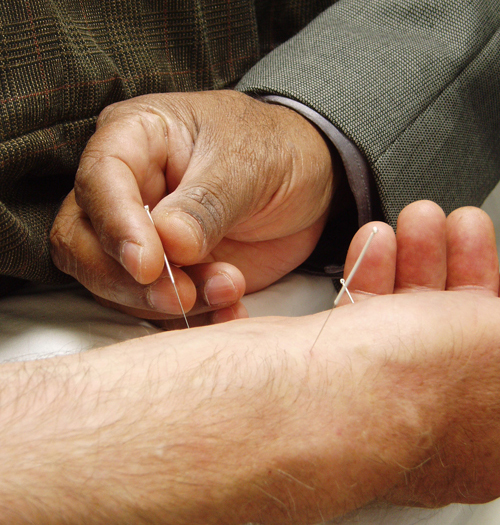Chiropractic Articles
Acupuncture
Acupuncture is a collection of procedures involving penetration of the skin with needles to stimulate certain points on the body. In its classical form it is a characteristic component of traditional Chinese medicine (TCM). It has been categorized as a complementary health approach. According to traditional Chinese medicine, stimulating specific acupuncture points corrects imbalances in the flow of qi through channels known as meridians. Scientific investigation has not found any histological or physiological correlates for traditional Chinese concepts such as qi, meridians, and acupuncture points, and some contemporary practitioners use acupuncture without following the traditional Chinese approach.
“Acupuncture’s use for certain conditions has been recognized by the United States National Institutes of Health, the National Health Service of the United Kingdom, the World Health Organization, and the National Center for Complementary and Alternative Medicine. “
The general theory of acupuncture is based on the premise that bodily functions are regulated by an energy called qi which flows through the body; disruptions of this flow are believed to be responsible for disease. Acupuncture describes a family of procedures aiming to correct imbalances in the flow of qi by stimulation of anatomical locations on or under the skin (usually called acupuncture points or acupoints), by a variety of techniques. The most common mechanism of stimulation of acupuncture points employs penetration of the skin by thin metal needles, which are manipulated manually or by electrical stimulation.

- Autism
- Chronic asthma
- Bell’s palsy
- Cocaine dependence
- Depression
- Drug detoxification
- Primary dysmenorrhoea (incorporating TENS)
- Enuresis
- Epilepsy
- Erectile dysfunction
- Fibromyalgia
- Glaucoma
- Gynaecological conditions (except possibly fertility and nausea/vomiting)
- Hot flashes
- Insomnia
- Irritable bowel syndrome
- Induction of childbirth
- Myopia
- Polycystic ovary syndrome
- Rheumatoid arthritis
- Shoulder pain
- Schizophrenia
- Smoking cessation
- Acute stroke
- and stroke rehabilitation
- Temporomandibular joint dysfunction.
- Tennis elbow
- Uremic pruritus
- Vascular dementia
Neck Pain
Neck pain, although felt in the neck, can be caused by numerous other spinal problems. Neck pain may arise due to muscular tightness in both the neck and upper back, or pinching of the nerves emanating from the cervical vertebrae. Joint disruption in the neck creates pain, as does joint disruption in the upper back. Two thirds of the population will suffer from neck pain at some point in their lives.
Leg Pain
The sciatic nerve is the largest nerve in the human body and one of the most common causes of leg pain. The term sciatica is used to describe the symptoms of pain occurring in the leg and lower back. Some use the term specifically to mean a nerve dysfunction caused by compression of one or more lumbar or sacral nerve roots from a spinal disc herniation.
When the liquid center of a disc bulges outwards, herniation occurs. The bulged disc can then tear against external ring fibers, contact the spinal canal, and compress a nerve root against the lamina or pedicle of a vertebra. This causes sciatica. The liquid extruded when this happens can cause inflammation and swelling of the surrounding tissue which can further compress the nerve root into the confined space of the spinal canal.
Sciatic pain typically runs through the lower back and down the sciatic nerve through the leg and can even run all the way down to the foot. Numbness, tingling, burning, and pricking sensations are all symptoms that may occur in cases of sciatic injury.
Sciatica is caused by compression of lumbar nerves, sacral nerves, and/or the sciatic nerve. Sciatic damage can be permanent, thus it is important that you seek medical attention if you are suffering from these symptoms.
Ice Therapy
The application of ice is an excellent way to reduce inflammation and temporary pain. Ice causes constriction in the veins of the affected tissue, limiting blood flow and acting as an anesthetic. Once the ice is removed, blood will rush back to the affected area providing nutrients that will help with the healing process.
Ice therapy is often used in the treatment of back and neck pain. It lessens the severity of muscle spasms, reduces pain by causing numbness, and aids in lessening soft tissue damage.
Ice or ice packs should be wrapped in a towel while being used for treatment. Ice therapy should be used on the affected area for 24 to 48 hours from the initial ache or injury. It is recommended to reapply it every 10 minutes for maximum affect and to not leave it on for more than 20 minutes at a time.
Patients suffering from rheumatoid arthritis, Raynaud’s Syndrome, colds or allergic conditions, paralysis, or areas of impaired sensation should not use ice therapy.
Heat Therapy
Most commonly used for rehabilitation purposes, heat therapy is the application of heat to the body for pain relief and health. It can be performed using something as simple as a heat to cloth to as advanced as ultrasound.
The therapeutic effects of heat include increasing the extensibility of collagen tissues; decreasing joint stiffness; reducing pain; relieving muscle spasms; reducing inflammation, edema, and aids in the post acute phase of healing; and increasing blood flow. The increased blood flow to the affected area provides proteins, nutrients, and oxygen for better healing.
Heat creates higher tissue temperatures, which produces vasodilation that increases the supply of oxygen, and nutrients and the elimination of carbon dioxide and metabolic waste. It is useful for muscle spasms, myalgia, fibromyalgia, contracture, and bursitis.Heat therapy can also be used for the treatment of headaches and migraines.
Heat therapy is only part of the therapeutic procedure that is chiropractic, and rarely provides a full extent of recovery without it.
Heat therapy should not be used on swollen or bruised tissues. It is advised that patients who have dermatitis, deep vein thrombosis, diabetes, peripheral vascular disease, open wounds, and cardiovascular conditions such as hypertension not use heat therapy.